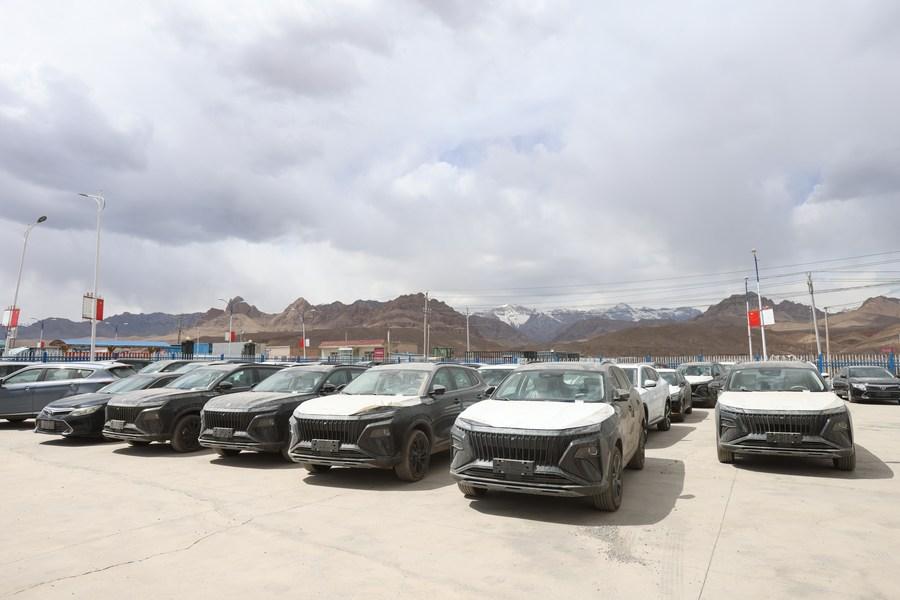Xinjiang land ports increase presence in Belt and Road economic ties
 0 Comment(s)
0 Comment(s) Print
Print E-mail Xinhua, November 10, 2023
E-mail Xinhua, November 10, 2023

This photo taken on April 25, 2023 shows vehicles to be exported at the Irkeshtam port in the Kizilsu Kirgiz Autonomous Prefecture, northwest China's Xinjiang Uygur Autonomous Region. [Photo/Xinhua]
Two major land ports in northwest China's Xinjiang Uygur Autonomous Region are bustling with trade this year amid stronger Belt and Road economic bonds, opening up greater opportunities for companies.
The ports of Irkeshtam and Torugart both border Kyrgyzstan and are gateways to Central Asia, West Asia and Europe, where many Belt and Road partners are located.
Irkeshtam customs data shows that by the end of October 2023, traded goods worth over 50.7 billion yuan (about 7 billion U.S. dollars) had passed through the port, up 52.1 percent year on year.
Torugart had handled traded goods worth 37.66 billion yuan in the first ten months, an increase of 49.78 percent compared with a year earlier, according to Li Wang, head of the port's administrative committee.
"The growth is remarkable, and is thanks to cooperation between Belt and Road participating countries boosted by events like the China-Central Asia Summit in May and the 22nd Meeting of the Council of Heads of Government of the Shanghai Cooperation Organization last month," said Li.
This growth is also palpable to many trade firms in Xinjiang. Ma Wenbang, general manager of a logistics and warehousing company near Irkeshtam, said business revenue so far this year has reached 14 million yuan, while it usually averaged 4 to 5 million yuan in previous years.
"Now around 70 percent of my warehouse space is heaped with goods, compared to an average of less than 20 percent since the company started in 2011," said Ma. The company mainly stores and transports exports bound for Uzbekistan.
Other firms in the same line of business have reported similar expansion. One such firm operating near Torugart is planning to add more warehouse space because its once near-empty shelves are all occupied this year.
Newcomers to Ma's warehouse this year are new energy vehicles (NEVs) from brands across China. NEV export is among the fastest-growing categories for both ports, with 40,000 units expected by Torugart this year, up from fewer than 10,000 last year.
Ping Xiaojian, general manager of an automobile exporter based near Torugart, said clients in Belt and Road participating countries like Uzbekistan, Kyrgyzstan and Russia are increasingly craving Chinese NEVs. Sales averaged about 500 units per month, up from 100 last year, he said.
Torugart is working to set up an industrial park for automobile trading, warehousing and bespoke services to further promote trade, said Li.
As energy cooperation between China and Central Asia deepens, more coal imports from Kyrgyzstan and Kazakhstan are expected to go through the two ports in the years to come to meet energy demands in south Xinjiang.
Many companies are already tapping this business. Xinjiang Zhongyuan Nanjiang Coal Storage and Distribution Co., Ltd started running a bonded warehouse for coal next to Irkeshtam in October. General Manager Zheng Yingfa said the port's proximity to mines in Kyrgyzstan could help cut logistics costs. The company aims at importing as much as 5 million tonnes of coal per year.
Torugart is expected to start handling coal imports from Kyrgyzstan next year, said Li. "If that goes well, annual trade through the port could exceed its designed capacity of 2 million tonnes per year," he added.






Go to Forum >>0 Comment(s)